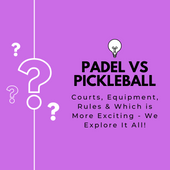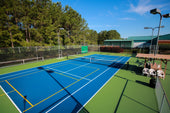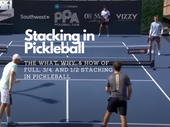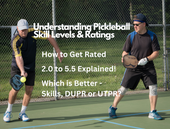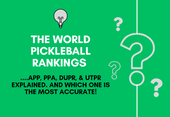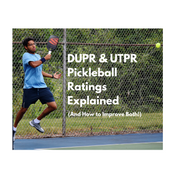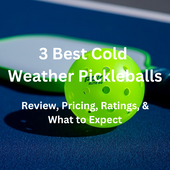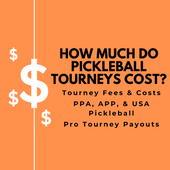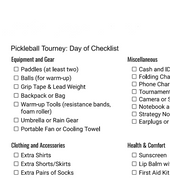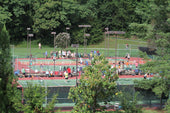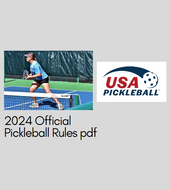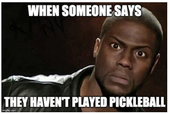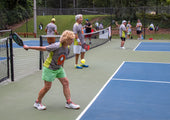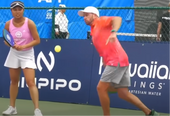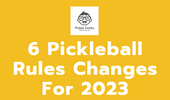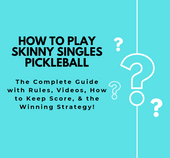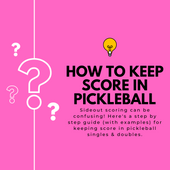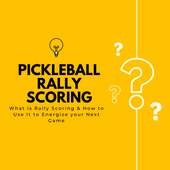No one wants their pickleball plans ruined by rain or a wet court!
However, since wet courts are slippery, it’s important to follow a few rules to reduce the risk of a fall or injury on a wet pickleball court.
In this article, we’ll quickly highlight what you need to know about playing pickleball in the rain, specifically highlighting:
- Can you play pickleball in the rain
- Tips for playing pickleball on a wet court
- Pickleball drills to do when it’s raining
- How to dry a wet court and what do do about your paddles getting wet
Ready? Let’s pickle!!
Can You Play Pickleball in the Rain?
Most outdoor pickleball courts have an acrylic finish that gets slippery when the surface gets wet from rain. It can be very easy to slip and fall on a wet court so it isn’t recommended to play pickleball in the rain or on a wet court. However, if you just have to get your pickleball fix, there are a few tips to reduce risk and even on court drills that don’t involve much movement that you can do in the rain or on a wet court.
Tips for Playing Pickleball on a Wet Court
No one wants a torn achilles, busted ACL, or an ankle sprain due to a slip and fall on a pickleball court.
While pickleball under a gentle drizzle might sound fun, wet courts can be slick and hazardous so safety should be your primary priority!
How to be safe on a wet pickleball court
To improve your odds of arriving back home injury-free, keep these safety tips in mind when playing pickleball in the rain:

Equipment and playing pickleball in the rain
If you venture out on the court in the rain, remember to wear the right equipment and take care of that expensive paddle!

How to Play Pickleball in the Rain
If you end up playing pickleball on a wet court, we don’t recommend playing normal singles or doubles games. Instead, there are several pickleball drills you can do in the rain or on a wet court.
Keep in mind the idea with these drills is to remain stationary or severely limit moving!!
Pickleball Drills When it's Raining
When playing pickleball in the rain, the key is to limit movement and do drills that allow you to stand in 1 place.
Here are 5 that we like:
- Dink Drills: Dinking doesn’t require much movement so it is a great skill to practice on a wet court. Practice cross court and down the line dinks and remember to hit every dink with intention (e.g., aim for a specific spot a few feet in front of your partner).
- Dink Volleys: Dink volleys are another great shot to practice on a wet court. Have 1 partner intentionally hit their dinks a foot or 2 higher than normal and the other partner practices a volley back. This is a challenging but under-rated shot on the pickleball court!
- “Fast Hands” Volley Drill: You’ll never have the hand speed of JW Johnson without practicing hand speed drills! For this drill, both partners stand at the kitchen line on opposite sides of the net (either diagonally or directly across from 1 another). Practice volleying at one another’s paddle, speeding up the pace of the ball as you get more comfortable. Remember to keep your racket head low (just above your waist) and in front of your body and practice hitting the ball as it gets close to your body (i.e., don’t reach too much or you’ll lose power and control!).
- Transition Area Reset Drill: Another great rainy day drill on a wet court is to practice reset shots from the transition zone. For this drill, have 1 partner stand at the kitchen line and the other midway between the kitchen and service lines. The partner at the kitchen then hits balls at the feet of the other player, who practices soft reset dinks back to the player at the kitchen line.
- Serves: Serves don't require much movement and are a great option for wet or slippery conditions. To get more out of the drill, set up a cone and practice serving to the target!
Playing Pickleball on a Wet Court - Summary
Playing pickleball in the rain isn't impossible, but it presents challenges. Prioritize safety, equip yourself correctly, and adjust your play and speed according to the conditions in order to prevent injury.
And when in doubt, save the game (and yourself!) for later!
Frequently asked questions (FAQs): Can you play pickleball on a wet court?
How do you dry a wet pickleball court?
Most pickleball and tennis courts are porous and made to dry faster than roads and sidewalks. However, they'll need sunshine or a little wind to dry fast. You can help the process by "squeeging" wet areas. Using towels to mop up standing water or even industrial fans to blow the court will both accelerate the drying process too.
Can you play pickleball in cold weather?
Yes, pickleball can be played in cold weather, but there are a few things to consider. The ball tends to become harder and less bouncy in cold conditions, potentially changing gameplay dynamics. In addition, most outdoor balls (e.g., Dura and Franklin) crack more easily at temperatures below 50 degrees F.

For colder days, players should dress in layers, stay active to maintain body warmth, and have plenty of balls since they are more likely to break in cold temps.
For more on playing in cold weather, including the best balls to use when temps dip, check out this post on playing pickleball in the cold.
What temp is too cold for pickleball?
There's no official temperature limit for playing pickleball. However, temperatures below 35°F (~0°C) will make the ball extremely hard, changing how it bounces on the court’s surface. In addition, most ball brands crack and break much more quickly at temps below 50 degrees F.
Can you get pickleball paddles wet?
Pickleball paddles can handle light moisture, but it's not advisable to get them drenched or leave them in wet conditions for extended periods.
Excess moisture can:
- Degrade the paddle's grip,
- Penetrate and affect its honeycomb core, and/or
- Compromise its overall durability
In addition, moisture can remove the rough “grit” on the surface of many paddles, impacting the paddle’s ability to grip the ball at impact.
If your paddle does get wet, dry your paddle after exposure and that will help prolong its lifespan.
What wind is too strong for pickleball?
While there's no strict wind speed limit for pickleball, winds exceeding 15 mph will significantly hinder gameplay, and even winds of 10 mph will impact the ball’s flight during rallies.
Pickleball’s are light with holes so wind can more easily affect the ball’s flight. Strong winds will alter the ball's trajectory, making serves, returns, and volleys unpredictable.
Can a pickleball bounce on grass?
A pickleball can bounce on grass, but not as predictably or high as on traditional hard courts. Grass surfaces can be uneven, affecting ball trajectory and bounce consistency.
So while it's possible to play pickleball on grass, players should be prepared for a different gameplay experience compared to more common court types.





